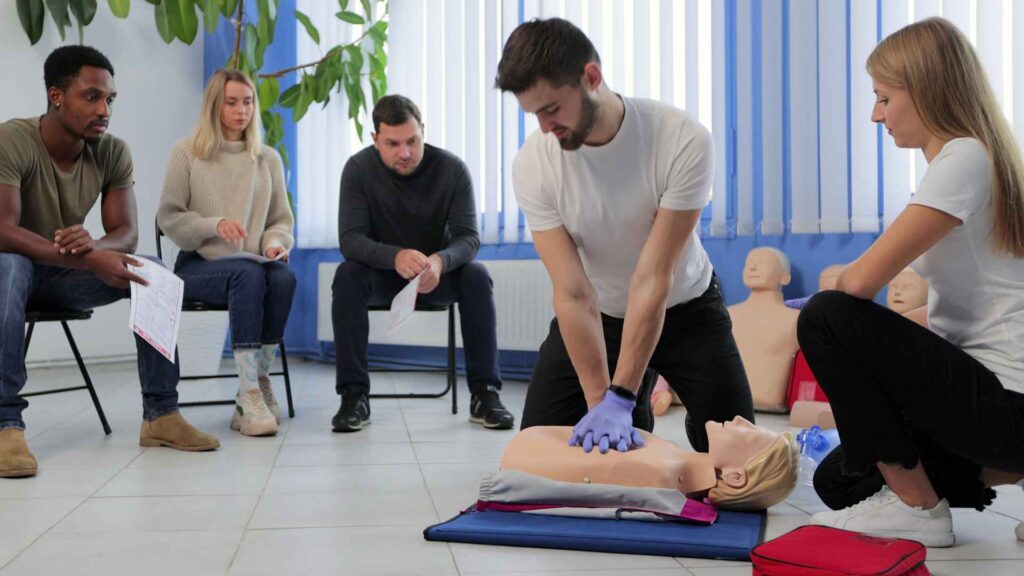Imagine finding yourself in a critical emergency situation where someone’s life is at risk, blood pouring uncontrollably from a severe limb injury. In that decisive moment, knowing when and how to use a tourniquet becomes a matter of life or death. First aid skills can be the difference between saving a life and feeling helpless. In this blog post, we will dive into the crucial topic of tourniquet usage in first aid, unravelling the key indicators, proper application techniques, and the critical decision-making process that can empower you to be a lifesaver when every second counts.

Understanding Tourniquets
You might have seen them in movies, but do you really know what a tourniquet is? According to the Canadian Red Cross guide, a tourniquet is a medical device that can be placed around an extremity (arm or leg) to control severe bleeding in emergencies. The main objective of a tourniquet is to constrict or compress a blood vessel to stop life-threatening bleeding until the person can receive appropriate medical care. It is essential to point out that EMR professionals sustain that tourniquets should only be used as a last resource when direct pressure and other methods have failed to control bleeding, as the application of this medical device has potential risks.
Types of tourniquets
In emergencies where the victim suffers from severe bleeding and disrupted blood flow, having the right tools to apply direct pressure can make all the difference. Medical responders usually have commercial tourniquets within their first aid kits, but there are also some improvised options that first aiders could use to help control blood flow and assist an individual.
- Commercial Tourniquets:
Commercial tourniquets are purpose-built medical devices specifically designed to control severe bleeding. They are usually made of durable materials such as nylon or elastic straps with mechanical or windlass mechanisms for tightening and securing. The main difference with improvised tourniquets is that they include a quick-release mechanism that allows easy application and removal after medical assistance. Some examples of commercial tourniquet brands include the Combat Application Tourniquet (CAT), the SOF Tactical Tourniquet (SOFTT), and the Emergency Bandage with an integrated tourniquet (Israeli bandage).
- Improvised Tourniquets:
Improvised tourniquets can be used temporarily when commercial tourniquets are not readily available within the first aid kit. As a bystander in an emergency, there are many everyday items that can be used to create an impromptu tourniquet, such as belts, ropes, clothing, and even sticks and rods for added leverage. In practice, improvised tourniquets are less effective or reliable than commercial ones; they can become handy to buy some time until a commercial tourniquet becomes available.
When to use a Tourniquet?

Last Resource
Bleeding emergencies can escalate in a matter of seconds, but an important note you must remember when facing one is that tourniquets are not the initial method for managing bleeding. In most cases, applying direct pressure is the first step in controlling life-threatening external bleeding, which helps ensure the bleeding stops and prevents further complications. At the same time, tourniquets are the last resort when the bleeding is uncontrollable or the severity or location of the injury requires a tourniquet. It is essential for a first aider to identify when to use tourniquets, especially when dealing with an injured person who is at risk of severe blood loss. Here are some examples that will help you in the assessment of the environment and patient;
- Profuse or uncontrollable bleeding of a limb:
There are some situations where the bleeding becomes uncontrollable. This could be due to arterial bleeding, characterized by bright red, spurting blood or a continuous flow of blood that cannot be controlled with manual compression. In such cases, it’s crucial to act quickly to control bleeding and prevent life-threatening blood loss in the injured person.
- Life-threatening injuries where bleeding cannot be controlled by direct pressure:
A tourniquet may be necessary if the injured person faces a severe laceration, puncture wound, or amputation, and direct pressure becomes ineffective in controlling the bleeding. The injury involves significant blood loss in these emergencies, and a tourniquet can help stop bleeding and prevent exsanguination. When applying a tourniquet, it’s essential to ensure it is tight enough to control bleeding but not so tight as to cause unnecessary damage. Rapid and significant blood loss can lead to hypovolemic shock, which reduces blood volume and causes inadequate perfusion of vital organs and tissues. This can be identified by symptoms such as pale skin, rapid pulse, and altered mental status. It’s important to note that the application of a tourniquet can be extremely painful, so the injured person may need reassurance during treatment.
- Injuries in remote or tactical environments where immediate medical assistance is not available:
Suppose the emergency is located in a wilderness area, combat zone or other scenarios where the injured individual is far from professional medical assistance. In that case, the use of a tourniquet may be warranted. A tourniquet can help buy time and prevent life-threatening bleeding until the patient is evacuated to a medical facility.

Learn How to Use a Tourniquet for Rapid Bleeding Control
In emergency situations where rapid bleeding, such as an arterial bleed, must be stopped swiftly, knowing how to properly apply a tourniquet can be life-saving. It is important to ensure the tourniquet is tight enough to control the bleeding but not too tight to cause further damage. Many first aid kits contain commercial tourniquets, but in situations where they are not available, improvised options can be used. This short video demonstrates essential techniques and steps to effectively use a tourniquet, empowering viewers with critical knowledge to respond effectively in urgent situations.
Master Life-Saving Skills with Our EMR Course!
Applying a Tourniquet
Knowing how to apply a tourniquet in an emergency situation is as vital as learning when to use one. It’s essential to ensure the tourniquet is tight enough to stop the bleeding but not so tight as to cause additional injury. Tourniquets should always be used cautiously by trained first aiders because their application can have potential risks and complications.
Step-by-step instructions to apply a tourniquet correctly
- Identify the site for tourniquet placement:
It is crucial to position the tourniquet proximate to the bleeding injury. It should generally be placed approximately 5 to 10 cm (2-4 inches) above the wound. If there is a joint, apply the tourniquet above it and at least 2.5 cm (1 inch) away from the joint. This ensures that the tourniquet effectively compresses the major blood vessels that can stop the bleeding. Before applying the tourniquet, ensure the injured person lie flat and is as calm as possible, as this can help reduce the risk of further complications and allow for more effective management of the injury.
- Securing the tourniquet tightly but not excessively:
Once it is positioned correctly, tighten it until the bleeding stops. The goal is to apply pressure to occlude the blood vessels without causing damage or excessive pain.
- Checking for cessation of bleeding after applying the tourniquet:
After the tourniquet is applied, check if the bleeding has completely stopped and monitor the area.
- Document the time of application:
It is crucial to write down the time of application for medical professionals to know how to proceed with the injury, assess the duration of tourniquet use and make informed decisions regarding its removal or potential complications.

Potential Risks and Limitations
As mentioned before, the use of tourniquets should be limited for trained first aiders and as a last resource when other methods for bleeding control become ineffective. After the assessment of the emergency, the first aider will determine if the benefits of the tourniquet overlap the potential risks associated with its use.
Besides all the pros tourniquets have in controlling severe bleeding, it is well known that they may cause nerve damage, limb ischemia and tissue damage.
- Nerve Damage: A tourniquet’s prolonged and excessive pressure can lead to nerve damage. If the tourniquet is applied directly over a nerve bundle or joint, the individual may face numbness, tingling, or permanent nerve injury.
- Limb ischemia and tissue damage: If the tourniquet is left in place for an extended period, it may lead to limb ischemia (inadequate blood supply), and prolonged ischemia can cause tissue damage, leading to muscle and nerve call death. Therefore, tourniquets should be minimized until medical assistance is available.

First Aid Training for Tourniquet use
In today’s unpredictable world, being prepared for emergencies is very important. Understanding how to respond effectively in critical moments can mean the difference between saving a life or exacerbating a situation. The proper use of tourniquets goes hand in hand with comprehensive first-aid training.
Investing in first aid training equips yourself and those around you with life-saving skills and knowledge. Through intensive and hands-on training, you will learn when to use a tourniquet and when to use other techniques. You will understand the indications, correct application, and potential risks involved. Plus, you will gain the confidence to act swiftly and decisively in an emergency.

















